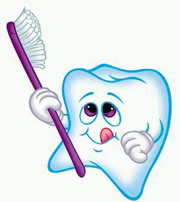 Teeth have to be very hard to withstand all the chewing and crunching of food. The hard material of the tooth is composed of calcium,
phosphorus, and other
mineral salts. The material in the majority of the tooth is called
dentine. The hard, shiny layer that you brush is called the
enamel. Teeth have to be very hard to withstand all the chewing and crunching of food. The hard material of the tooth is composed of calcium,
phosphorus, and other
mineral salts. The material in the majority of the tooth is called
dentine. The hard, shiny layer that you brush is called the
enamel.
Teeth have two basic parts, a root to anchor the tooth to the jaw and a crown above the gum line. The root is covered with a hard material called
cementum. At the center of each tooth is an area with nerves, arteries and veins called the
dental pulp.
Humans have four different types of teeth, each with a different function:
Incisorsfor cutting off bites of food.
Cuspids(sometimes called canines because of their long sharp points) for tearing food
Bicuspids(with two points) to tear and crush food
Molarswith large relatively flat surfaces to crush and grind food.
Our four different types of teeth together are called collective
dentitionand they allows humans to be
omnivores(eating both meat and vegetables). Most animals have more specialized teeth. Carnivorous (meat eating) animals have long sharp tearing teeth (like our incisors and cuspids).
Grazing animals, like cows and horses have large flat teeth (like our molars) for grinding grass and other vegetation.
|
|
note:
|
phosphorus: 磷
mineral salt: 天然盐
dentine: 牙质
enamel: (牙齿的)釉质
cementum: 牙骨质
dental pulp: 牙髓
incisor: 门牙
cuspid: 犬齿
bicuspid: 两尖齿
molar: 臼齿
dentition: 齿系
omnivore: 不偏食的人
grazing animal: 食草动物
|
|
